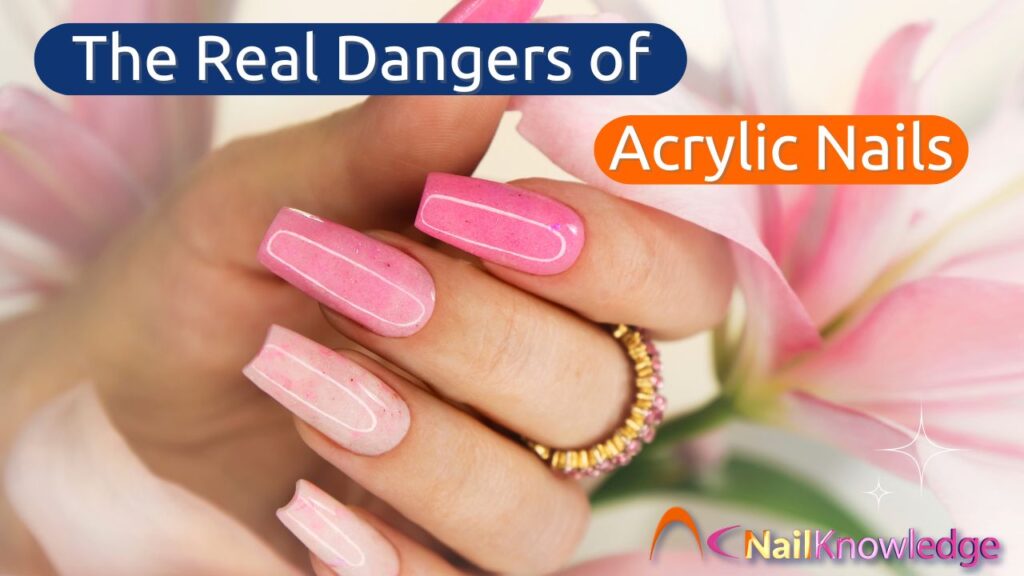Lo que nos dicen los últimos avances científicos
There’s something undeniably satisfying about a fresh set of acrylics. The glossy finish, the perfect length, the instant confidence boost, it’s easy to see why they’re a go-to for so many. But new research is prompting an important question: are we fully aware of the potential risks behind those polished tips? According to recent findings from the University of Nevada, Reno, the dangers of acrylic nails go beyond the usual wear and tear, and it’s time we had an honest conversation about it.
🧪 What’s New in the Science of Acrylic Nails?
Acrylic enhancements (all enhancements that need to cure with either a UV LED lamp or air dry as L&P) have long been a staple in nail salons, celebrated for their durability and aesthetic appeal. However, this new study dives into the less glamorous side, specifically, the chemical compounds released during application and wear. Investigadores highlighted concerns over substances like methyl methacrylate (MMA), toluene, and formaldehyde resin. These aren’t new names in the beauty world, but their impact is becoming clearer as our understanding of toxicology evolves.
Según el estudio, la exposición repetida a determinados vapores and dust created during filing or curing can lead to respiratory irritation, skin sensitivity, and, in some cases, more serious systemic effects. Now, does this mean acrylics are inherently dangerous? Not quite—but it does mean we need to get smarter about how and when they’re used.
💬 El punto de vista de NailKnowledge: la ciencia debe dar forma a la práctica
At NailKnowledge, we’ve always advocated for education-first practices. The beauty industry moves fast, but we believe science should move faster. These findings don’t mean a full stop on acrylics—but they do call for a fresh look at safety standards, product choices, and client communication.
Para los profesionales, es un recordatorio:
- Elija alternativas más seguras a los productos químicos de alto riesgo (evite MMA at all costs, it’s banned in many places for a reason).
- Asegúrese de que su salón dispone de sistemas de ventilación eficaces.
- Use proper PPE when filing or removing acrylics, especially during high-dust procedures.
- Keep up with Material Safety Data Sheets (MSDS) and manufacturer updates.
For clients, it’s about informed choices. Ask questions. Understand what’s being applied to your nails. If your technician can’t tell you what’s in the products they’re using, that’s a red flag.
🔍 Los verdaderos peligros de las uñas acrílicas
One of the most compelling points in the University of Nevada study was around cumulative exposure. While a single acrylic application likely won’t cause harm, it’s the repeated and prolonged exposure, particularly in poorly ventilated salons, that raises concerns. Imagine it like a dripping tap. One drop? Not a problem. But over time, that constant drip fills a bucket and potentially overflows.
And it’s not just about clients. Nail techs are on the frontlines of this exposure daily. This is why updated education and rigorous health standards are non-negotiable in our industry.
🔄 Actualizar juntos nuestros conocimientos
We’re not here to sensationalise, we’re here to support. As new research emerges, so do better practices. That’s why we’re reviewing older NailKnowledge articles and updating where necessary. If past guidance no longer reflects current science, we’ll flag it. Transparency isn’t a trend, it’s a responsibility.
🧠 Entonces, ¿qué debe hacer?
If you’re a nail pro:
- Stay current with ingredient safety. Don’t assume a product is safe just because it’s on the shelf.
- Dé prioridad a su formación y a la de sus clientes. La concienciación conduce a resultados más seguros.
- Abogue por la mejora de los protocolos de seguridad en su lugar de trabajo.
If you’re a client:
- Don’t be afraid to ask your technician about the products being used.
- Busque salones que valoren la higiene, la ventilación y la transparencia.
- Pay attention to how your nails and skin react, your body often tells you when something’s not right.
🗣 Editor’s Note (April 2025)
Este artículo ha sido actualizado para reflejar nuevas investigaciones sobre los riesgos de exposición química de las uñas acrílicas. NailKnowledge mantiene su compromiso con la educación basada en la evidencia y anima a nuestra comunidad a mantenerse informada a medida que la ciencia evoluciona.
📢 Queremos saber de usted
Have a question about this new research? Or think we need to re-evaluate a past recommendation? Email us at [email protected] We’re building a community of learners, not know-it-alls.
Al fin y al cabo, las uñas nunca deben ir en detrimento de la salud. Los peligros de las uñas acrílicas son reales, pero controlables. Las uñas acrílicas pueden tener cabida en la decoración moderna. cuidado de las uñas, when we use them wisely, with a full understanding of what’s involved


